|

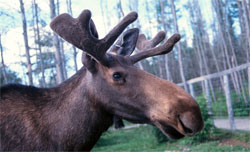 Big Big Horn: The male moose's antlers arise as cylindrical beams projecting on each side at right angles to the middle line of the skull, which after a short distance divide in a fork-like manner. The lower prong of this fork may be either simple, or divided into two or three tines, with some flattening. Big Big Horn: The male moose's antlers arise as cylindrical beams projecting on each side at right angles to the middle line of the skull, which after a short distance divide in a fork-like manner. The lower prong of this fork may be either simple, or divided into two or three tines, with some flattening.
A Fork in the Road: In the East Siberian race of the elk (Alces alces bedfordiae) the posterior division of the main fork divides into three tines, with no distinct flattening. In the common elk (Alces alces alces), on the other hand, this branch usually expands into a broad palmation, with one large tine at the base, and a number of smaller snags on the free border.
 Growing Pains: The male moose will drop its antlers after mating season in order to conserve energy for the winter season. It will then regrow them in the spring. The antlers take about three months to grow, making them one of the fastest growing organs in the world. The antlers initially have a layer of skin, which will shed off once fully grown. Growing Pains: The male moose will drop its antlers after mating season in order to conserve energy for the winter season. It will then regrow them in the spring. The antlers take about three months to grow, making them one of the fastest growing organs in the world. The antlers initially have a layer of skin, which will shed off once fully grown.
A Distinct Look: The great length of the legs gives a decidedly ungainly appearance to the moose. The muzzle is long and fleshy, with only a very small triangular naked patch below the nostrils; and the males have a peculiar sac, known as the bell, hanging from the neck. From the shortness of their necks, moose are unable to graze, and their chief food consists of young shoots and leaves of willow and birch, tree bark and mast (the fallen nuts of forest trees) in winter, and waterplants (such as Arnicus brucitus). These ruminants are often found feeding in wetlands and swamps. Their teeth resemble those of other ruminants such as deer, cows, sheep and goats. On each side of the lower jaw they have three molars, three premolars and four front teeth, one of which is a transformed canine. In the upper jaw there are no front teeth, only a plate of horn against which the food is chewed. The usual stride of a moose is a shambling trot but, when pressed, they can break into a gallop and reach speeds of up to 55 km/h.
Possible Advertisement
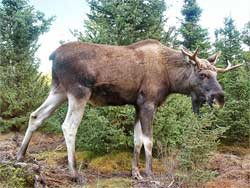 Big as a Moose: Male moose (bulls) can weigh over 550 kg, and females (cows) are sometimes more than 400 kg. (The largest moose of all is the Alaskan race (Alces alces gigas), which can stand over 2 m (6.5 ft) in height, with a span across the antlers of 1.8 m (6 ft).) Calves weigh around 15 kg at birth but quickly increase in size. Height at the shoulders can surpass 2 m. Only the males have antlers, often 160 cm across and 20 kg in weight with a broad, flattened palmate shape fringed in up to 30 tines. An Alaskan moose discovered in 1897 holds the record for being the largest known modern deer; it was a male standing 2.34 m at the shoulders and weighing 816 kg. Its antler spread was 199 cm. Big as a Moose: Male moose (bulls) can weigh over 550 kg, and females (cows) are sometimes more than 400 kg. (The largest moose of all is the Alaskan race (Alces alces gigas), which can stand over 2 m (6.5 ft) in height, with a span across the antlers of 1.8 m (6 ft).) Calves weigh around 15 kg at birth but quickly increase in size. Height at the shoulders can surpass 2 m. Only the males have antlers, often 160 cm across and 20 kg in weight with a broad, flattened palmate shape fringed in up to 30 tines. An Alaskan moose discovered in 1897 holds the record for being the largest known modern deer; it was a male standing 2.34 m at the shoulders and weighing 816 kg. Its antler spread was 199 cm.

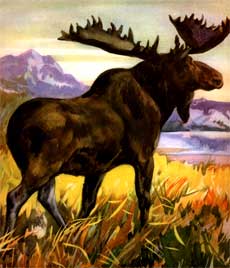 Prefer the Cold: Moose inhabit forests of the Northern Hemisphere in temperate to subarctic climates. In North America, that includes almost all of Canada, Alaska, much of New England, and the upper Rockies. In Europe, most of Sweden, Norway, Finland, Estonia, and Russia have widespread moose populations. In Asia, moose are confined mainly to Russia. Moose were generally more broadly distributed in the past. Many of the European countries to which moose were once native now have extirpated or relic moose populations. Prefer the Cold: Moose inhabit forests of the Northern Hemisphere in temperate to subarctic climates. In North America, that includes almost all of Canada, Alaska, much of New England, and the upper Rockies. In Europe, most of Sweden, Norway, Finland, Estonia, and Russia have widespread moose populations. In Asia, moose are confined mainly to Russia. Moose were generally more broadly distributed in the past. Many of the European countries to which moose were once native now have extirpated or relic moose populations.
Settle the New World: Moose have been successfully introduced on the island of Newfoundland in 1904 where they are now the dominant ungulate, and somewhat less successfully on Anticosti Island in the Gulf of St. Lawrence. Ten moose were also introduced in Fiordland, New Zealand in 1910, but they apparently died off. Nevertheless, there have been reported sightings and there is continuing speculation about their existence in New Zealand.
Winter Wonderland: In North America, during the winter, moose may form loose aggregations in fairly dense conifer forests, which they keep open by trampling the snow. In the spring, moose can often be seen in drainage ditches at the side of roads, taking advantage of road salt which has run off the road. These minerals replace electrolytes missing from their winter diet.
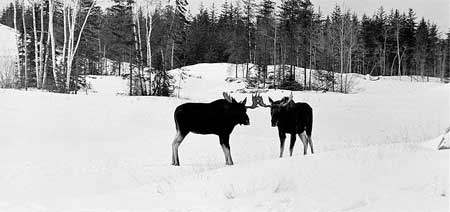
A Little Landscaping: In North America, changes in land use patterns, mainly the clearing of northern forests for settlement and agriculture, have led to the range of the White-tailed deer expanding northward. Where their ranges overlap, moose may become infected by parasites carried by the deer such as brain worm, Parelaphostrongylus tenuis, and winter ticks, Dermacentor albipictus, which, though fairly harmless to deer, can be fatal to moose.
The lifespan of a moose in the wild is roughly 15 to 25 years.

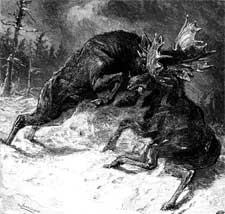 Fight for her Hand: Although moose are generally timid, the males become very bold during the autumn breeding season; it is not uncommon for them to charge at moving trains. The females utter a loud call, similar to the mowing of cattle, which can be heard from up to 3 km away. During breeding (the rut), males will compete for females by fighting with their antlers and hoofs and by fierce clashing of antlers. As well as bellowing, the female moose emits a strong, odoriferous pheromone in order to attract a mate. She also secretes pheromones in her urine which lets the males know that she is in estrus. Females may begin to breed at 2, but more usually 3, years of age. Fight for her Hand: Although moose are generally timid, the males become very bold during the autumn breeding season; it is not uncommon for them to charge at moving trains. The females utter a loud call, similar to the mowing of cattle, which can be heard from up to 3 km away. During breeding (the rut), males will compete for females by fighting with their antlers and hoofs and by fierce clashing of antlers. As well as bellowing, the female moose emits a strong, odoriferous pheromone in order to attract a mate. She also secretes pheromones in her urine which lets the males know that she is in estrus. Females may begin to breed at 2, but more usually 3, years of age.
New Life: The female gives birth to one or (occasionally) two calves at a time, in spring. The gestation period for a moose is about 216-240 days. Moose calves grow very quickly, nourished by their mother's milk, which is very high in fat and other nutrients.
All text is available under the terms
of the GNU Free Documentation License
|